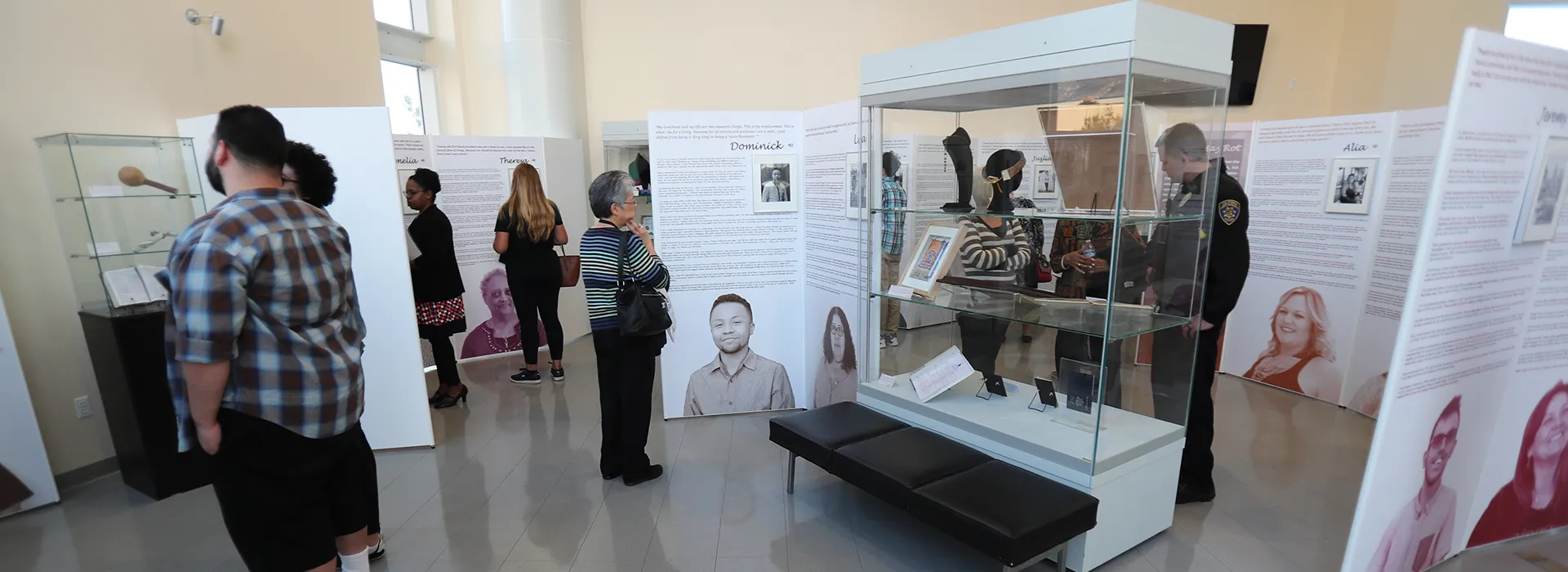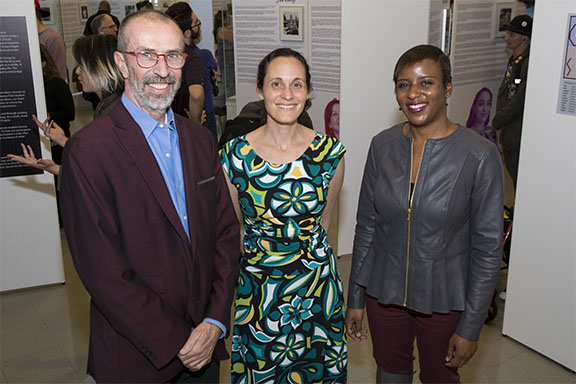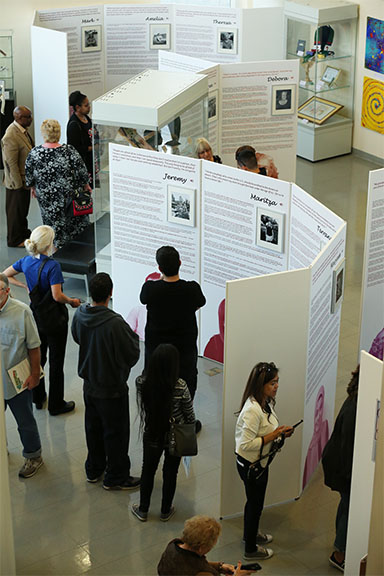Joe Gutierrez Office of Strategic Communication (909) 537-5007 joeg@csusb.edu

“In|Dignity,” an exhibit aimed at exploring and dismantling intolerance through the experiences of Inland Empire residents, officially opened at Cal State San Bernardino’s Anthropology Museum on Jan. 18 and will remain on display through Dec. 11.
In|Dignity takes its title from a double entendre simultaneously reading as a single word — indignity — and two separate words — in dignity.

“These two meanings capture precisely what the exhibition explores: experiences with oppression, discrimination, and prejudice, and simultaneously the pride and self-respect that we must have for ourselves and for others facing such injustices,” said director of the Anthropology Museum and exhibition co-curator Arianna Huhn.
The exhibition centers on the stories of community participants who volunteered to share intimate details of their lives “in the hope that doing so would help promote conversation, introspection and change in the way we interact with each other,” said Annika Anderson, co-curator and assistant professor of sociology, at the exhibit’s opening reception on Jan. 18.
In|Dignity shares life experiences of Inland Empire community members in their own words on giant displays that also feature portraits of them by Thomas McGovern, CSUSB professor of art. The exhibit becomes even more personal through the audio interviews where museum visitors can hear the voices of the participants telling their stories.
“They are powerful stories to read,” Huhn said. “They are more powerful to listen to.”
“In collecting these stories, we offer our community the cathartic experience of sharing their hurt, anguish, frustration, despair and hope,” said Anderson. “By presenting the stories and experiences of our neighbors, colleagues and friends in their own words, we celebrate our community and refresh a sense of local pride, civic spirit and belonging, while also inspiring visitors to be more empathetic — which is an important tool for reducing intolerance.”
It is the curators’ vision that engagement with personal stories of stigmatized and marginalized “others” will break down barriers of misunderstanding and self-defense, inspire empathy, and instill a pledge for personal and societal change.
The indignities considered in the exhibition are wide-ranging and include personal experiences with ableism, androcentrism, cisgenderism, Islamophobia, racism, heterosexism, educationalism, ageism, colorism, size-ism, pro-natalism and other axes of life outside of the societal “norm.”

Visitors can explore the exhibition on their own, or through its stock of evolving “concept cards,” which highlight several narratives in relation to a common topic.
The curators arranged In|Dignity into seven thematic sections:
Color | Lines
In this section, community members illuminate the significance and use of color in their lives — including how color can be used to divide, to unite and to celebrate humanity.
Invisible
In this section, community members reflect on how being ignored, hidden or muted has impacted their identities and lived experiences.
Petrified
In this section, community members share personal stories that can help to soften preconceived notions about groups and individuals who our social upbringing often tells us to fear, to disparage and to avoid.
Stones May Rot
In this section, community participants share how words have impacted their self-perceptions, and propelled their life decisions, in the moment and over time.
Embodied
In this section, community members consider how our bodies can bind us and free us, and how outward appearances can reveal and conceal what is inside of our soul.
I Raise Up My Voice
In this section, community members consider the societal expectations of women, and share their experiences breaking the mold and crafting opportunities for empowerment, self-definition and advancement.
Empower
In this section, community participants share their experiences, wisdom and requests for support.
In|Dignity was made possible with support from California Humanities, a nonprofit partner of the National Endowment for the Humanities. Additional financial support for In|Dignity is provided by CSUSB students through their Instructionally Related Programs Fee, a CSUSB Office of Student Research Faculty/Student Grant, the CSUSB Office of Community Engagement Service Learning Fellowship and Community-Based Research Mini-Grant, and a Mervyn M. Dymally African American Political and Economic Institute Research Grant.
The opening reception for In|Dignity is sponsored by the CSUSB University Diversity Committee.
About In|Dignity
Curators: Arianna Huhn and Annika Anderson.
Assistant Curators: Lark Winner, Ana Gonzalez and Jackie Gervacio.
Photography: Thomas McGovern.
Audio Editing: James Trotter, Estefania Torres, Cory McCormick, Bryant Uribe and Vaidehiba Rana.
Concept Cards: Annika Anderson and Kelly Campbell.
Logistics and Installation: Steven Huhn and Heather Roessler.
Additional Assistance: Wendy Martinez, Valeria Velez Zaragoza, Kimberly-Anne Anacleto and CSUSB students enrolled in Anth 102 (fall 2016) and Soc 360 (winter 2017).
About the Anthropology Museum
The CSUSB Anthropology Museum was founded in 2000. Located within the College of Social and Behavioral Sciences building at Cal State San Bernardino, the breathtaking gallery space provides expansive views of the surrounding San Bernardino and San Gabriel mountains.
The mission of the Anthropology Museum is to serve as a teaching laboratory for Museum Studies Certificate students, who gain hands-on experience in collections management, exhibition planning, curation and museum administration. The museum additionally provides space for the presentation of exhibitions that illustrate and interrogate the cultural contexts and meanings of community histories, events, identities and behaviors — locally, across the world and over time — and other anthropological perspectives on topics of interest.
The museum is open 9 a.m.-4 p.m., Monday-Friday. Guided tours and weekend visits can be arranged with advanced notice by contacting the museum director at (909) 537-5505. Admission is free; parking at CSUSB is $6.
Visit the Anthropology Museum website for more information.